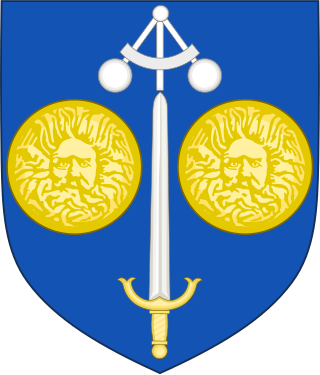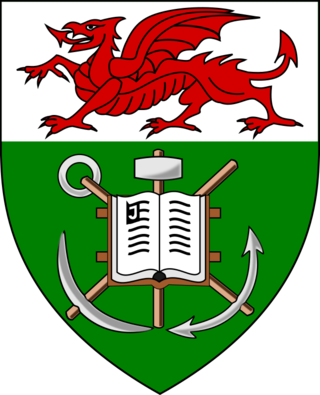
South West England, or the South West of England, is one of the nine official regions of England in the United Kingdom. It consists of the counties of Cornwall, Dorset, Devon, Gloucestershire, Somerset and Wiltshire. Cities and large towns in the region include Bath, Bristol, Bournemouth, Cheltenham, Exeter, Gloucester, Plymouth and Swindon. It is geographically the largest of the nine regions of England with a land area of 9,203 square miles (23,836 km2), but the third-least populous, with approximately 5.7 million residents.

Bristol Temple Meads is the oldest and largest railway station in Bristol, England. It is located 118 miles 31 chains away from London Paddington. It is an important transport hub for public transport in the city; there are bus services to many parts of the city and surrounding districts, with a ferry to the city centre. Bristol's other major station, Bristol Parkway, is a more recent station on the northern outskirts of the conurbation. It is the busiest station in South West England.

The University of Bath is a public research university in Bath, England. It received its royal charter in 1966, along with a number of other institutions following the Robbins Report. Like the University of Bristol and University of the West of England, Bath can trace its roots to the Merchant Venturers' Technical College, established in Bristol as a school in 1595 by the Society of Merchant Venturers. The university's main campus is located on Claverton Down, a site overlooking the UNESCO World Heritage city of Bath, and was purpose-built, constructed from 1964 in the modernist style of the times.

Swansea University is a public research university located in Swansea, Wales, United Kingdom.
The Doctor of Engineering is a professional doctorate in engineering and applied science. An EngD is a terminal degree similar to a PhD in engineering but applicable more in industry rather than in academia. The degree is usually aimed toward working professionals.

The South West of England Regional Development Agency (SWRDA) was one of the nine Regional Development Agencies set up by the United Kingdom government in 1999. Its purpose was to lead the development of a sustainable economy in South West England, investing to unlock the region's business potential. It was abolished along with all the other RDAs on 31 March 2012, with some of its functions being replaced by local enterprise partnerships.

University Alliance (UA) is an association of British universities formed in 2006 as the Alliance of Non-Aligned Universities, adopting its current name in 2007.
Rail services in the West of England refer to passenger rail journeys made in the Bristol commuter area. 17 million passenger rail journeys were made in 2019-20 within the Gloucestershire, Wiltshire and Bristol/Bath region.
Silicon Gorge is a region in South West England in which several high-tech and research companies are based, specifically the triangle of Bristol, Swindon and Gloucester. It was ranked fifth of such areas in Europe in 2002, and is named after the Avon Gorge.

Swansea University Medical School is a medical school on Swansea University's Singleton campus. It is linked to additional teaching centres located throughout South and West Wales, including Cefn Coed Hospital, Singleton Hospital and Morriston Hospital in Swansea, Prince Philip Hospital in Llanelli, Withybush General Hospital in Haverfordwest and Bronglais Hospital in Aberystwyth. The Medical School also has a network of primary care teaching centers.

In the 2010s Network Rail modernised the Great Western Main Line, the South Wales Main Line, and other associated lines. The modernisation plans were announced at separate times but their implementation overlapped in the 2010s.

Wales & West Utilities operates the gas distribution network across Wales and South West England in the United Kingdom. It also provides the gas emergency service and delivers the iron mains risk reduction programme in those areas.

Several centers for supercomputing exist across Europe, and distributed access to them is coordinated by European initiatives to facilitate high-performance computing. One such initiative, the HPC Europa project, fits within the Distributed European Infrastructure for Supercomputing Applications (DEISA), which was formed in 2002 as a consortium of eleven supercomputing centers from seven European countries. Operating within the CORDIS framework, HPC Europa aims to provide access to supercomputers across Europe.

Autism Cymru was Wales' national charity for autism with offices in Cardiff, Wrexham, and Aberystwyth. The charity was established in May 2001 through an initial 3-year grant provided by The Shirley Foundation. The founder chair of the Trustees was Dame Stephanie Shirley of the Shirley Foundation.
Cara Carmichael Aitchison,, FWLA, FLSW is a British social scientist and university leader. She was President and Vice Chancellor of Cardiff Metropolitan University from 2016 to 2024, and was formerly Vice-Chancellor and Chief Executive or Plymouth Marjon University in England (2013–2016). She was previously Dean of Moray House School of Education and Professor in Social and Environmental Justice at Edinburgh University in Scotland (2010–2013) and has an international research profile in the geography and cultural economy of leisure, sport and tourism and in gender studies, cultural identity and social inclusion.
Great Western Cities is a collaborative initiative launched in February 2015 by the cities of Bristol, in England, and Cardiff and Newport, in Wales, to improve cooperation in the area as a city region, and to develop economic and environmental partnerships.
The Cray XC50 is a massively parallel multiprocessor supercomputer manufactured by Cray. The machine can support Intel Xeon processors, as well as Cavium ThunderX2 processors, Xeon Phi processors and NVIDIA Tesla P100 GPUs. The processors are connected by Cray's proprietary "Aries" interconnect, in a dragonfly network topology. The XC50 is an evolution of the XC40, with the main difference being the support of Tesla P100 processors and the use of Cray software release CLE 6 or 7.
Nora Henriette de Leeuw is the inaugural executive dean of the Faculty of Engineering and Physical Sciences at University of Leeds. Her research field is computational chemistry and investigates biomaterials, sustainable energy, and carbon capture and storage.
The A64FX is a 64-bit ARM architecture microprocessor designed by Fujitsu. The processor is replacing the SPARC64 V as Fujitsu's processor for supercomputer applications. It powers the Fugaku supercomputer, ranked in the TOP500 as the fastest supercomputer in the world from June 2020, until falling to second place behind Frontier in June 2022.

Regional economy in Wales is centred on four regional economic boards in Wales. Each board oversees a city or growth deal, signed between 2016 and 2022, lasting 10–15 years. Two of the deals are city deals signed and proposed by their respective economic boards, and their areas are described as "city regions"; the Cardiff Capital Region and Swansea Bay City Region. Whereas in North Wales, the North Wales Economic Ambition Board negotiated a North Wales growth deal signed in 2020, and in Mid Wales, the Growing Mid Wales Partnership, led negotiations for a Mid Wales growth deal signed in 2022. The programmes are based on the City deal and Growth deal initiatives set up by the Coalition UK Government in 2012, to promote the decentralisation of the UK economy, by stimulating local economic growth.













